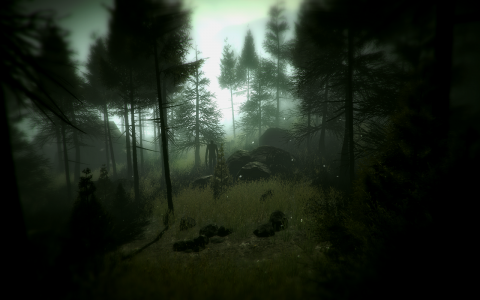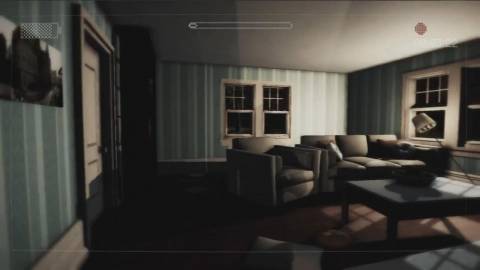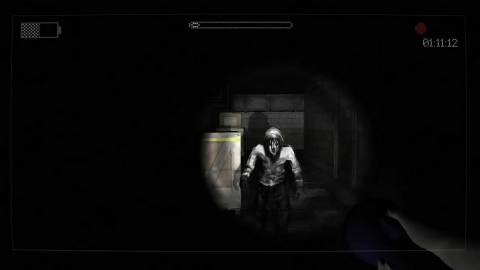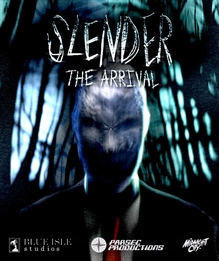The experience of Slender: The Arrival is much like that of opening a Christmas present that you'll never love

Much like the original Slender, Slender: The Arrival has a bone chilling atmosphere, a well done sense of loneliness, and the rare appearance of the Slender Men that keeps the player tensed up till it's released in the most horrifying of ways. However, even though The Arrival hits all of those original points, it stretches them out too thin, and ends up falling flat.
The first thing that you'll notice about The Arrival is the new look. The game is much improved over its predecessor; the environments are much more detailed. The trees look more like trees, as opposed to the sticks with leaves that were found in the original title, and the Slender Man looks more terrifying and real then he previously did -- not that that's a reason to stare of course; he’ll kill you if you do.
The entirety of The Arrival is played through the "eyes" of Laurens camera, the games protagonist. Blue Isle Studios and Parsec Productions, developers of Slender: The Arrival, have implemented a great feature that fits both the tone and the gameplay well. The camera essentially acts as a way of knowing when the Slender Man is near; when looking at the Slender Man the camera will pick up interference and fill with static, in other cases the camera will flicker on and off or flash white light.
These telltale signs of the Slender Mans presence add a great amount of tension to the game; as you don’t know when or where the mythical beast is going to appear, the feeling of his imminent approach made me nervous throughout the game.
Gameplay in The Arrival is largely similar to that of its predecessor; run around with a flashlight and collect a certain number of items while avoiding the tall man in a suit stalking you. There are one or two things that have been added to keep the game interesting, however. The first of which is interactivity; while there isn’t a lot of it – only two of the levels feature this in any prominent way – you can interact with doors and windows. The prologue level introduces this mechanic to the player.

After crashing your car you head off down the road to Kate’s house, Laurens friend. Once you’ve reached the house the sun has gone down, it was day time when you crashed the car, and you find that the door is closed and nobody is in the house. This is where the game teaches the player the door opening/closing mechanic. To open a door the player only has to look at it, hold down the mouse button and then move the mouse in a motion similar to that of opening a real door. Using this mechanic to open/close doors isn’t always as easy as it should be; sometimes the door would swing back into my face and block my advance, other times I found that the door wouldn’t swing shut because I wasn’t moving the mouse in the right direction. Annoyances like these shouldn’t exist in a horror game that’s dependent on you moving quickly through an environment in order to get away from something.
Interacting with windows was also a dodgy task; but not in the way that the doors are. Opening and closing windows was easy and simple (grab and pull), however, it was selecting the window that was the hassle. More often than not I found that I had to move or look in a certain direction in order for the game to pick up that I wanted to interact with a window; this became more apparent when I was rushed to do so in a later mission. Interacting with the windows and doors is an interesting mechanic; I only wish that it would work better.
The second addition to the gameplay is the new enemy type. In the original title, your one and only enemy was the Slender Man; in its sequel the white face horror now has the help of his proxies; proxies, according to Slender Man lore, are the servants of Slender Man. Unlike their master, however, proxies are a lot more aggressive, chasing and then tackling you when you can’t run away.
The proxies are an interesting addition to Slender; the screams and noises that give you a heads up of their approach made a shiver go up my spine every time I heard it. However, the proxies don’t make a great addition to the series; the only drawback of letting them catch you is an up close shot of their hideous face, they also appear in only one level which may leave some disappointed.
If you’re not too fond of being tackled by a psychotic slave, than there is way for you to fight the proxies; although it wasn’t till my second or third time playing through the same level that I realized it. Clicking the right mouse button will focus your flashlight and, if you’re aiming at it, stun the proxy. Even though I found that it was quicker and easier to let them tackle me, I found myself constantly aiming my flashlight at the proxies face while I moved through the environment – which was a self-inflicting annoyance but an annoyance none the less. By the end of the game I was happy that there was only one level that implemented the proxies; their low risk nature made them more of an annoyance than an actual benefit to the game.

The added additions to the gameplay can largely be overlooked and don’t add that much to the game itself. This seemed to bleed over to the story as well; which was almost obsolete in the previous game and has been added for its sequel. Written by MarbleHornets the story is centered on Lauren, the protagonist, and her endeavors to find her friend Kate.
The game is split up into five missions; each of them is set in a different location, aside from a later flashback mission that takes place in the house from the prologue, and they each have their own hidden collectibles. These twenty-six collectibles fill in a majority of the games story; some will be numbered letters, written by CR, a friend of Kate, while others may be simple decorations or items that tell you a little about the location that your currently in.
The sad thing about The Arrivals story is the fact that the majority of it is locked behind hidden collectibles. In a game that’s designed on moving forward and not looking back, the act of looking through the environments to find lost letters takes away from the experience (I also had to play through the game a second time to find all of them). The letters also don’t explain pieces of the story; even after I collected all the letters I felt that I was missing significant parts of it.
Slender: The Arrival is a fully realized game, with a good amount of levels, great visuals, and good atmosphere. But following the success of the original game and trying to live up its name isn’t easy, and The Arrival just doesn't do it justice; the gameplay that made the original title so great is stretched to its limit in the sequel. Seeing the Slender Man still gives me scare, but the game quickly becomes a bore and doesn't offer up the level of horror that its predecessor did.
